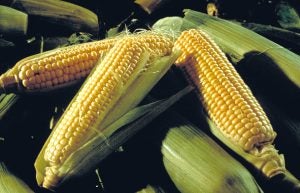A team of Agricultural Research Service, university, and industry scientists has spotted a new genetic vulnerability to tolpyralate herbicide in 49 varieties of corn, marking the first report of weed control posing a danger to the staple crop.
The finding, reported in the journal Pest Management Science, will enable farmers to avoid crop losses, such as by choosing a tolpyralate-tolerant variety or by using a different herbicide product.
According to Marty Williams, an ecologist with the ARS Global Change and Photosynthesis Research Unit in Urbana, Illinois, tolpyralate was registered in 2017 and labeled for use in fallow fields and on all types of field-, pop- and- sweet corn. It belongs to a class of herbicides known as HPPD (4-Hydroxyphenylpyruvate dioxygenase) inhibitors.
When applied as a post-emergent herbicide, tolpyralate triggers a biochemical chain of events in targeted weeds that initially causes bleached-appearing leaves and then ultimately plant death.
Normally, corn plants can quickly metabolize HPPD inhibitor herbicides before they inflict the same kind of harm. The process depends on the presence or absence of certain types of alleles (alternate gene copies) in a region of their genome known as NSF1.
One way that corn breeders check for the alleles during evaluations of new candidate varieties is to spray them with nicosulfuron. It is an acetolactate synthase enzyme-inhibiting herbicide that can also serve as a reliable indicator of a variety’s sensitivity to several types of post-emergence herbicides, including most ALS and HPPD inhibitors. As it turns out, however, spraying nicosulfuron isn’t a reliable indicator of corn tolerance to tolpyralate.
That’s what Williams and his collaborators from the University of Wisconsin-Madison and Illinois Foundation Seed Inc. learned after conducting a series of greenhouse, field, and laboratory tests using genetic mapping techniques. They began their investigation in late summer 2021 after a corn breeder’s report that spraying tolpyralate onto a sweet corn inbred line called XSEN187 had severely damaged all plants.
But instead of the alleles they expected to see, the team traced the sweet corn inbred line’s tolpyralate sensitivity to a cluster of genes residing on a unique region of chromosome 5. This was confirmed by the alleles’ association with visible tolpyralate damage in two populations of offspring plants that were derived from crosses between the sweet corn inbred and two tolerant corn lines.

The researchers expanded the scope of their investigation, ultimately identifying tolpyralate sensitivity in a total of six types of field corn and 43 types of sweet corn. Additional screening is likely to detect the trait in other varieties as well. Consider the case of the inbred line IL677a, which was used to introduce the widely popular sugary enhancer gene to sweet corn. In tests, the line proved severely sensitive to tolpyralate, raising the possibility that this sensitivity was also widely introduced into sweet corn along with the sugar enhancer trait.
Importantly, the researchers also showed that tolpyralate sensitivity in the corn lines they evaluated is contingent upon exposure to oil-based adjuvants, additives that are mixed into herbicide tanks before application. However, removing them isn’t an option, Williams noted. The adjuvants are key to ensuring the herbicide is absorbed into the leaves of targeted weeds, killing them more effectively.
How exactly the newly identified gene or genes on chromosome 5 make these varieties vulnerable to harm from tolpyralate hasn’t been figured out yet. “We need a greater understanding of the physiological mechanism so that the manufacturer and seed companies can reduce the risk of crop injury, such as by improving crop tolerance to the herbicide,” Williams said. “Moreover, the research may have application beyond tolpyralate, because several new HPPD-inhibiting herbicides are being developed from the same pyrazole ring scaffold as tolpyralate.”


